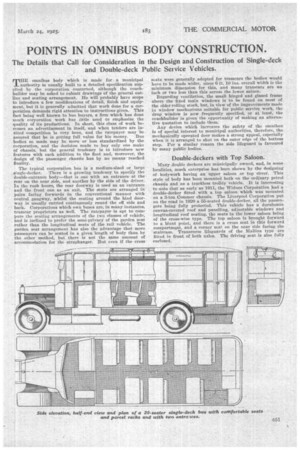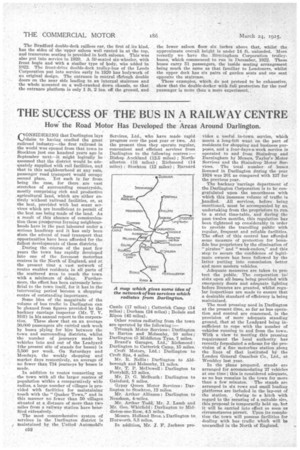POINTS IN OMNIBUS BODY CONSTRUCTION.
Page 35

Page 36

If you've noticed an error in this article please click here to report it so we can fix it.
The Details that Call for Consideration in the Design and Construction of Single-deck and Double-deck Public Service Vehicles.
THE omnibus body which is made for a municipal authority is usually built to a detailed specification supplied by the corporation concerned, although the coachbuilder may be asked to submit drawings of the general outline and seating arrangement. He will probably have scope to introduce a few modifications of detail, finish and equipment, but it is generally admitted that work done for a corporation demands rigid attention to instructions given. This fact being well known to bus buyers, a firm which has done much corporation work has little need to emphasize the quality of its productions. In short, this class of work becomes an advertisement in itself, and when tenders are invited competition is very keen, and the ratepayer may be assured that he is getting full value for his money. Bus bodies so made may be more or less standardized by the corporation, and the decision made to buy only one make of chassis, but the general tendency is to introduce new features with each addition to the fleet and, moreover, the design of the passenger chassis has by no means reached finality.
The typical corporation, bus is a medium-sized or largo • single-decker. There is a growing tendency to specify the double-entrance body—that is one with an entrance at the rear on the near side, and another by the side of the driver. In the rush hours, the rear doorway is used as an entrance and the front one as an exit. The seats are arranged in pairs facing forwards in the conventional manner with central gangway, whilst the seating around the hind doorway is usually carried continuously round the off side and back Corporations which own buses are, in many instances, tramcar proprietors as well. The ratepayer is apt to compare the seating arrangements of the two classes of vehicle, and is inclined to prefer the semi-privacy of the garden seat rather than the longitudinal seats of the rail vehicle. The garden seat arrangement has also the advantage that more passengers can be seated in a given length of body than by the other method, but there is not the same amount of accommodation for the straphanger. But even if the cross seats were generally adopted for tramcars the bodies would have to be made wider, since 6 ft. 10 ins, overall width is the minimum dimension for this, and many tramcars are an inch or two less than this across the lower saloon.
Regarding ventilation, the small hinged and glazed frame above the fixed main windows is to be found on most of the older rolling stock, but, in view of the improvements made in window mechanisms suitable for public service work, the drop window is now frequently specified, or at least, the coachbuilder is given the opportunity of making an alternative quotation to include them.
Any device which increases the safety of the omnibus is of special interest to municipal authorities, therefore, the mechanically operated door makes a strong appeal, especially when it is arranged to shut on the outer edge of the bottom. step. For a similar reason the side lifeguard is favoured by many public bodies.
Double-deckers with Top Saloon.
Many double deckers are municipally owned, and, in some localities, much enterprise has been shown by the designing of bodywork having an upper saloon or top ewer. This style of body has been mounted both on the ordinary petrol chassis and as a trackless trolley vehicle. It is interesting to note that as early as 1911, the 'Widnes Corporation hail a double-decker fitted with a top saloon which was mounted on a 3-ton Commer chassis. The Liverpool Corporation put on the road in 1920 a 55-seated double-decker, all the passengers being fully protected. This vehicle has a duralumin canvas-covered roof and panelling, adjustable windows and longitudinal roof seating, the seats in the lower saloon being of the cross-wise type. The top saloon is brought forward to a blunt point, and there is a cross seat in this forward compartinqnt, and a corner seat on the near side facing the staircase. Transverse lifeguards of the Mallins type are fitted in front of both axles. The driving seat is also fully enclosed. The Bradford double-deck railless ear, the first of its kind, has the sides of the upper saloon well canted in at the top, and transverse seating is provided in both saloons. This was also put into service in 1920. A 59-seated six-wheeler, with front bogie and with a similar type of body, was added in 1922. The front-drive double-deck trolley-bus of the Leeds Corporation put into service early in 1920 has bodywork of an original design. The entrance is central ttrbugh double doors on the near side leading to an internal staircase and the whole mounted on a well-cranked down chassis, so that the entrance platform is only 1 ft. 2 ins. off the ground, and
the lower saloon floor six inches above that, whilst the approximate overall height is under 14 ft. unloaded. More recently we have the Birmingham Corporation trolleybuses, which commenced to run in December, 1922. These buses carry 51 passengers, the inside seating arrangement being much the same as that familiar to Londoners, whilst the upper deck has six pairs of garden seats and one seat opposite the staircase.
These examples, whieh do not pretend to be exhaustive, show that the double-decker with full proteetien for the roof passenger is more than a mere experiment. ,
























































